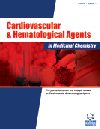- Home
- A-Z Publications
- Cardiovascular & Hematological Agents in Medicinal Chemistry (Formerly Current Medicinal Chemistry - Cardiovascular & Hematological Agents)
- Previous Issues
- Volume 22, Issue 1, 2024
Cardiovascular & Hematological Agents in Medicinal Chemistry (Formerly Current Medicinal Chemistry - Cardiovascular & Hematological Agents) - Volume 22, Issue 1, 2024
Volume 22, Issue 1, 2024
-
-
The Platelet Aggregation Inhibition Activity of Polyphenols can be Mediated by 67kda Laminin Receptor: A New Therapeutic Strategy For the Treatment of Venous Thromboembolism
More LessAuthors: Satya Prakash, Amit Ghosh, Arnab Nayek and Sheetal KiranBackground: Thrombotic disease is still a major killer. Aspirin, Ticagrelor, Clopidogrel, etc. are the most widely used conventional antiplatelet drugs. The significant number of patients who are resistant to this drug shows a poor outcome. Objective: Developing a new antiplatelet agent with a stable antiplatelet effect and minimal bleeding risk is required for a patient who is resistant to antiplatelet drugs. Methods: Protein-ligand Read More
-
-
-
The Negative Effects of Statin Drugs on Cardiomyocytes: Current Review of Laboratory and Experimental Data (Mini-Review)
More LessStatin drugs have long been used as a key component of lipid-lowering therapy, which is necessary for the prevention and treatment of atherosclerosis and cardiovascular diseases. Many studies focus on finding and refining new effects of statin drugs. In addition to the main lipidlowering effect (blocking cholesterol synthesis), statin drugs have a number of pleiotropic effects, including negative effects. The ma Read More
-
-
-
High-sensitive Cardiospecific Troponins: The Role of Sex-specific Concentration in the Diagnosis of Acute Coronary Syndrome (Mini-Review)
More LessCardiospecific troponins are specifically localized in the troponin-tropomyosin complex and the cytoplasm of cardiac myocytes. Cardiospecific troponin molecules are released from cardiac myocytes upon their death (irreversible damage in acute coronary syndrome) or reversible damage to cardiac myocytes, for example, during physical exertion or the influence of stress factors. Modern high-sensitive immunochemical m Read More
-
-
-
A Patent Review on Cardiotoxicity of Anticancerous Drugs
More LessAuthors: Renu Bhadana and Vibha RaniChemotherapy-induced cardiotoxicity is an increasing concern and it is critical to avoid heart dysfunction induced by medications used in various cancers. Dysregulated cardiomyocyte homeostasis is a critical phenomenon of drug-induced cardiotoxicity, which hinders the cardiac tissue's natural physiological function. Drug-induced cardiotoxicity is responsible for various heart disorders such as myocardial infarction, myoc Read More
-
-
-
A Comprehensive Insight on Pharmacological Properties of Cilnidipine: A Fourth-generation Calcium Channel Blocker
More LessAuthors: Renu Kadian and Arun NandaPreventing the development of cardiovascular problems is a key objective of antihypertensive drugs. Many of the non-pressure related coronary risk factors for hypertension are thought to be connected to an increase in sympathetic activity. The sympathetic systems have N-type calcium channels at the nerve terminals that control neurotransmitter release. Cilnidipine is a unique fourth-generation calcium channel blocker Read More
-
-
-
Protective Effect of Nigella sativa Seed Extract and its Bioactive Compound Thymoquinone on Streptozotocin-induced Diabetic Rats
More LessAuthors: Samar S. Khan and Kamal Uddin ZaidiBackground: The lack of a substantial breakthrough in the treatment of diabetes, a global issue, has led to an ongoing quest for herbs that contain bioactive elements with hypoglycemic properties. Objective: To investigate the potential protective effect of Nigella sativa seeds ethanol extract and its active ingredient, thymoquinone, on streptozotocin-induced diabetic rats. Methods: To induce diabetes, the male Wistar rats were ad Read More
-
-
-
Evaluation of the Effectiveness of Dantrolene Sodium against Digoxininduced Cardiotoxicity in Adult Rats
More LessBackground: Digoxin poisoning commonly occurs in people treated with digoxin. It has been suggested that treatment with dantrolene may be a suitable strategy for digoxin-induced cardiotoxicity. Objective: The aim of this study was to evaluate the protective effect of dantrolene on digoxininduced cardiotoxicity in male rats. Methods: This study was approved by the ethics committee of Birjand University of Medical Sc Read More
-
-
-
Organosulfur Compounds in Aged Garlic Extract Ameliorate Glucose Induced Diabetic Cardiomyopathy by Attenuating Oxidative Stress, Cardiac Fibrosis, and Cardiac Apoptosis
More LessAuthors: Kumkum Sharma and Vibha RaniBackground: Diabetic cardiomyopathy has emerged as a major cause of cardiac fibrosis, hypertrophy, diastolic dysfunction, and heart failure due to uncontrolled glucose metabolism in patients with diabetes mellitus. However, there is still no consensus on the optimal treatment to prevent or treat the cardiac burden associated with diabetes, which urges the development of dual antidiabetic and cardioprotective cardiac thera Read More
-
-
-
L-Tartaric Acid Inhibits Diminazene-induced Vasorelaxation in Isolated Rat Aorta
More LessAuthors: Ayoub Amssayef, Ismail Bouadid and Mohamed EddouksAims: The study investigated the effect of L-tartaric acid on diminazene-indiuced vasorelaxation. Background: Diminazene is known to induce vasorelaxation through the stimulation of angiotensin- converting enzyme (ACE-2). Objective: This work was designed to study the effect of L-tartaric acid on diminazene-induced vasorelaxation using an ex vivo approach. Materials and Methods: In the current investigation, the i Read More
-
-
-
Subthreshold Doses of Inflammatory Mediators potentiate One Another to Elicit Reflex Cardiorespiratory Responses in Anesthetized Rats
More LessAuthors: Ravindran Revand, Sanjeev K. Singh and Madaswamy S. MuthuBackground: Reflex cardio-vascular and respiratory (CVR) alterations evoked by intraarterial instillation of nociceptive agents are termed vasosensory reflexes. Such responses elicited by optimal doses of inflammatory mediators have been described in our earlier work. Objective: The present study was designed to evaluate the interactions between subthreshold doses of inflammatory mediators on perivascular nocice Read More
-
Volumes & issues
-
Volume 23 (2025)
-
Volume 22 (2024)
-
Volume 21 (2023)
-
Volume 20 (2022)
-
Volume 19 (2021)
-
Volume 18 (2020)
-
Volume 2 (2020)
-
Volume 17 (2019)
-
Volume 16 (2018)
-
Volume 15 (2017)
-
Volume 14 (2016)
-
Volume 13 (2015)
-
Volume 12 (2014)
-
Volume 11 (2013)
-
Volume 10 (2012)
-
Volume 9 (2011)
-
Volume 8 (2010)
-
Volume 7 (2009)
-
Volume 6 (2008)
-
Volume 5 (2007)
-
Volume 4 (2006)
Most Read This Month
Article
content/journals/chamc
Journal
10
5
false
en


